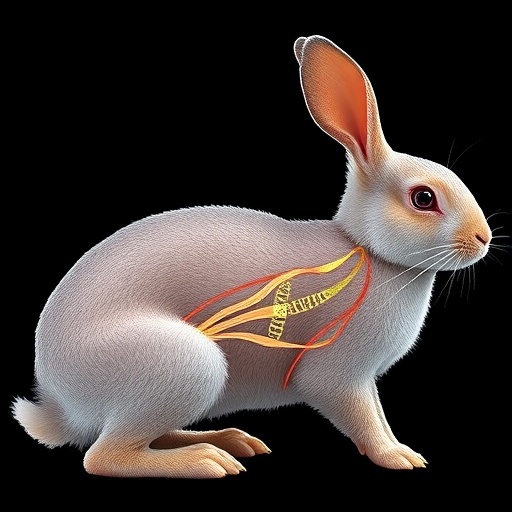In an insightful exploration of the genetic mechanisms behind intramuscular fat deposition in rabbits, researchers led by Wang, H., Chen, Y., and Zhao, C. have conducted a comprehensive transcriptome analysis. Their findings hold significant implications not only for the agricultural sector but also for the understanding of fat deposition processes in various species, including humans. The study, published in BMC Genomics, provides valuable insights into the genetic framework that regulates fat distribution and composition in livestock, an area that is critical for enhancing meat quality and production efficiency.
Intramuscular fat, also known as marbling, is a vital determinant of meat quality, affecting factors such as tenderness, juiciness, and flavor. This qualitative aspect of meat has gained increasing attention from meat scientists and breeders alike, as consumer preferences continue to evolve toward higher-quality meat products that offer both sensory appeal and nutritional value. The present study by Wang and colleagues sheds light on the intricate biological networks that orchestrate fat deposition at the muscular level in rabbits, a model organism well-suited for such genetic investigations.
Through meticulous transcriptome sequencing of muscle tissues from rabbits, the research team was able to identify a multitude of key genes implicated in the processes governing fat deposition. The transcriptomic analysis not only mapped the expression levels of these genes but also elucidated the regulatory pathways involved in the synthesis and metabolism of lipids. Such insights are crucial for developing more targeted breeding strategies aimed at enhancing intramuscular fat content without compromising the overall health and growth performance of the animals.
The methodology employed by the researchers is noteworthy, incorporating advanced sequencing technologies that allow for a high-resolution view of gene expression profiles across various developmental stages. By comparing the transcriptomic data from different muscle samples, the team effectively pinpointed candidate genes that correlated with increased intramuscular fat. These findings are a testament to the power of modern genomic technologies to unravel complex biological phenomena that have long evaded scientists.
Among the key findings, several candidate genes emerged as critical regulators of fatty acid metabolism. Notably, genes associated with lipid biosynthesis, such as fatty acid synthase (FAS) and stearoyl-CoA desaturase (SCD), demonstrated significant upregulation in samples with higher intramuscular fat content. This highlights the fundamental role of these genes in the accumulation of fat within muscle tissues and underscores their potential as targets for genetic selection in breeding programs.
Moreover, the study revealed a network of regulatory interactions among these fat-associated genes, encompassing various signaling pathways that influence adipose tissue development and fat storage. The identification of transcription factors that bind to the regulatory regions of these genes provides a deeper understanding of how gene expression is modulated in response to developmental cues and nutritional inputs. Such complex regulatory mechanisms are essential for fine-tuning the balance of energy storage and expenditure in livestock.
In addition to the primary focus on fat deposition, the research also delves into the broader implications of these genetic insights for meat production practices. With the global demand for high-quality meat products on the rise, there is a pressing need for innovative breeding strategies that can enhance meat quality traits efficiently and sustainably. Understanding the genetic basis of intramuscular fat deposition enables breeders to select for desirable traits more effectively, contributing to improved meat quality and increased profitability within the industry.
The broader context of this study also resonates with ongoing research in human health, particularly regarding obesity and related metabolic disorders. The mechanisms governing fat deposition are fundamentally conserved across species, and insights gained from animal models like rabbits can provide valuable parallels to human physiology. By deciphering the genetic underpinnings of fat accumulation, researchers can better understand the etiology of obesity and devise novel therapeutic strategies aimed at metabolic regulation.
Furthermore, the implications of this study extend beyond the realm of genetics; they also encompass nutritional aspects that influence fat deposition in livestock. The interaction between diet and gene expression is a critical area of exploration, as nutritional strategies can be optimized to enhance the expression of beneficial genes while suppressing those associated with undesirable fat deposition. By integrating genomic data with nutritional science, a more holistic approach can be developed to maximize meat quality.
As the research community continues to unravel the complexities of genetic regulation surrounding fat deposition, it becomes increasingly clear that a multidisciplinary approach is essential. Collaborations among geneticists, animal scientists, and nutritionists will likely yield novel insights that can foster innovation and sustainability in the agricultural sector. This study by Wang and his team represents a significant step in that direction, paving the way for future investigations that may translate into practical solutions for improving livestock breeding and meat production.
In conclusion, the transcriptome analysis conducted by Wang, Chen, and Zhao provides groundbreaking insights into the key genes and regulatory networks involved in intramuscular fat deposition in rabbits. Their findings underscore the potential for genomic tools to revolutionize breeding practices aimed at enhancing meat quality. As the field of agricultural genomics advances, the lessons learned from this research could have far-reaching implications, shaping the future of meat production and contributing to the global endeavor of delivering high-quality protein to meet growing consumer demands.
With a comprehensive understanding of the genetic factors at play, it becomes evident that the future of livestock improvement lies in embracing the sophisticated techniques of modern genomics. Such advancements not only promise to enhance the quality of meat but are also crucial for ensuring the sustainability and efficiency of agricultural practices in an ever-changing world.
Subject of Research: Intramuscular fat deposition in rabbits.
Article Title: Transcriptome analysis reveals key genes and regulatory networks underlying intramuscular fat deposition in rabbits.
Article References:
Wang, H., Chen, Y., Zhao, C. et al. Transcriptome analysis reveals key genes and regulatory networks underlying intramuscular fat deposition in rabbits.
BMC Genomics 26, 785 (2025). https://doi.org/10.1186/s12864-025-11950-x
Image Credits: AI Generated
DOI: 10.1186/s12864-025-11950-x
Keywords: Transcriptome analysis, intramuscular fat, genetic regulation, meat quality, breeding strategies.




